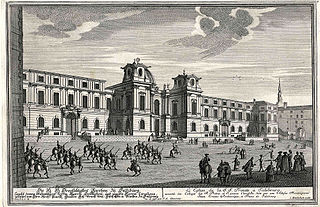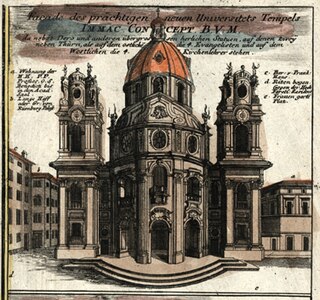Background
The first date to appear on the score is June 1828, although evidence exists that Schubert had begun to sketch it earlier than this. It was completed by July. It was composed in response to a commission or request from Michael Leitermayer, choirmaster of the Church of the Holy Trinity (Alserkirche) in Alsergrund, Vienna. The mass was not performed until after Schubert's death, with a premiere in the Alserkirche on October 4, 1829. Ferdinand Schubert conducted the premiere, as well as a second performance in the Church of Maria Trost on November 15, 1829.
The influence of Beethoven is felt in the mass, particularly in the "ambitious Beethovenian architecture". [7] Schubert had been a torchbearer at Beethoven's funeral, which had been held in the Alserkirche. References to Bach's fugues are present in the Gloria and Agnus Dei, as well as Mozart's Requiem and Haydn's Heiligmesse .
This setting and the earlier Mass in A-flat major are regarded as Schubert's "late masses". These are distinguished from his four early masses by their "musically interpretive stance to the words"; Schubert began to take advantage of an overall maturation in his technical capabilities and knowledge of harmony, coupled with his experience in composing both sacred and secular music, to add further meaning to the standard text. Already known for consistently omitting certain passages from the text, Schubert took even greater freedoms in the late masses, adding and removing text in a bid to "deepen expression or enhance a particular aspect of meaning".
The Schubert scholar Brian Newbould opined that the late masses were the composer's "two finest and most substantial settings", calling the Mass in E-flat "the triumph and swansong of [Schubert's] career (as far as the composition of masses is concerned)", although he also admits that it has "unevenness". Schubert's biographer Kreissle von Hellborn wrote that the Mass in E-flat "takes rank with the foremost compositions of the kind written at the time".
The late masses may have influenced the composition of Bruckner's Mass in F minor.
Rieter-Biedermann [ de ] published the first edition of the piano score in 1865, anonymously edited by Johannes Brahms.

Great Mass in C minor, K. 427/417a, is the common name of the musical setting of the mass by Wolfgang Amadeus Mozart and considered one of his greatest works. He composed it in Vienna in 1782 and 1783 after his marriage when he moved to Vienna from Salzburg. This large-scale work, a missa solemnis, is scored for two soprano soloists, a tenor and a bass, double chorus and large orchestra. It remained unfinished, missing large portions of the Credo and the complete Agnus Dei.

Mass No. 2 in G major, D 167, by Franz Schubert was composed in less than a week in early March 1815 and remains the best known of his three short settings, or missae breves, dating between his more elaborate No. 1 and No. 5. Apart from some passages for soprano, its solistic interventions are modest; Schubert, characteristically, inclines toward a devotional mood. The First Mass had been successfully performed in the composer's parish the year before.

The Missa in Angustiis or Nelson Mass, is one of fourteen masses written by Joseph Haydn. It is one of the six masses written near the end of his life which are, together, now seen as a culmination of Haydn's liturgical composition.
The Piano Sonata in F-sharp minor D 571, was composed by Franz Schubert in July 1817. The sonata was first published long after the composer's death in 1888 by Breitkopf & Härtel.
The Mass No. 13 in B-flat major, Hob. XXII/13, was composed by Joseph Haydn in 1801. It is known as the Schöpfungsmesse or Creation Mass because of the words "Qui tollis peccata mundi" in the Gloria, Haydn recycled music from the Adam and Eve's final duet in The Creation, a fact which scandalized Empress Maria Theresa so much that she ordered Haydn to recompose that passage for her own copy of the work.

The Missa solemnis, WAB 29, is a solemn mass composed by Anton Bruckner in 1854 for the installation of Friedrich Mayer as abbot of St. Florian Abbey on 14 September 1854.

The Missa Sancti Bernardi von Offida is a mass in B-flat major by Joseph Haydn, Hob. XXII:10, Novello 1, was written the same year as the Missa in tempore belli (1796), and it "may have been the first mass Haydn wrote after his return from England." Yet it may also have been the second. It is usually given as Haydn's ninth setting of the mass, though its Hoboken number is XXII:10. This mass was written in honor of St. Bernard of Offida, a Capuchin monk who devoted himself to helping the poor; a century after the monk's death, he was beatified by Pope Pius VI.

The Missa Cellensis in honorem Beatissimae Virginis Mariae in C major by Joseph Haydn, Hob. XXII:5, Novello 3, was originally written in 1766, after Haydn was promoted to Kapellmeister at Eszterháza following the death of Gregor Joseph Werner. The original title as it appears on the only surviving fragment of Haydn's autograph score, that has been discovered around 1970 in Budapest, clearly assigns the mass to the pilgrimage cult of Mariazell, Styria. Until that discovery, the work was known as Missa Sanctae Caeciliae, or in German Cäcilienmesse, a title probably attributed to the mass in the 19th century. Whether the alternative title refers to a performance of the piece by the St. Cecilia's Congregation, a Viennese musician's fraternity, on some St. Cecilia's day, as has been suggested, remains speculation.

The Missa brevis No. 9 in B-flat major by Wolfgang Amadeus Mozart, K. 275/272b, was probably written before September 1777 for Salzburg. The mass is scored for SATB soloists, SATB choir, violin I, violin II, 3 trombones, string bass, and organ.

The Missa brevis in G major, K. 140, K3 Anh. 235d, K6 Anh. C 1.12, was probably composed by Wolfgang Amadeus Mozart shortly after returning to Salzburg, in March 1773, from his third trip to Italy.
Michael Haydn completed the Missa in honorem Sanctae Ursulae, Klafsky 1:18, MH 546, on August 5, 1793, probably for use at the ceremony in which Ursula Oswald, the daughter of a friend, professed her religious vows at the Benedictine Abbey of Frauenwörth Chiemsee. Because of that fact, the Mass is sometimes known as the Chiemsee Mass.

The Missa in honorem Sanctissimae Trinitatis in C major, K. 167, is a mass composed by Wolfgang Amadeus Mozart in June 1773. It is scored for SATB choir, violin I and II, 2 oboes, 2 clarini, 2 trumpets, timpani and basso continuo.

The Missa solemnis in C major, K. 66, is a mass composed by Wolfgang Amadeus Mozart in 1769. It is scored for SATB soloists and choir, violins I and II, viola, 2 oboes, 2 horns, 2 clarini, 2 trumpets and basso continuo.

The Missa brevis in D minor, K. 65/61a, is a mass composed by Wolfgang Amadeus Mozart and completed on 14 January 1769. It is scored for SATB soloists and choir, violin I and II, 3 trombones colla parte, and basso continuo.

Stabat Mater in F minor, D 383, is a musical setting of the Stabat Mater sequence, composed by Franz Schubert in 1816. It is scored for soprano, tenor and bass soloists, SATB choir, 2 flutes, 2 oboes, 2 bassoons, contrabassoon, 2 french horns, 3 trombones, violin I and II, viola, cello and double bass.

The Deutsche Messe, D 872, is a hymn-cycle by Franz Schubert written in 1827. Neither a Mass nor strictly speaking German, it was published in Vienna as what it is: Gesänge zur Feier des heiligen Opfers der Messe. It sets a sequence of eight non-liturgical German poems by Johann Philipp Neumann, who commissioned Schubert's music, one or more of which could be used separately during Mass. A ninth hymn, given as an appendix, treats the Lord's Prayer, bringing the length to about 35 minutes when the music is performed, as it often now is, as one big concert work.

Mass No. 1 in F major, D 105, is a mass composed by Franz Schubert in 1814. It is scored for two soprano soloists, two tenor soloists, alto and bass soloists, SATB choir, oboe, clarinet, bassoon, 2 horns, violin I and II, viola, and basso continuo. It was the first of Schubert's masses to be performed, and is of the missa solemnis type.

The Mass No. 3 in B-flat major, D 324, is a mass composed by Franz Schubert in 1815. It is four soloists, a four-part choir and orchestra. While by length it could be a missa brevis, its large orchestral force with trumpets, timpani and woodwinds has also led to its classification as a missa solemnis.

Mass No. 4 in C major, D 452, is a mass composed by Franz Schubert in 1816. It was originally scored for soprano, alto, tenor and bass soloists, SATB choir, violin I and II, and basso continuo. It is classified as a missa solemnis.

Mass No. 5 in A-flat major, D 678, is a mass composed by Franz Schubert, completed in 1822. There is no record of a performance during Schubert's lifetime. It is scored for soprano, alto, tenor and bass soloists, SATB choir with divisi, violin I and II, viola, flute, 2 oboes, 2 clarinets, 2 bassoons, 2 horns, 2 trumpets, 3 trombones colla parte, timpani and basso continuo. It is classified as a missa solemnis.














